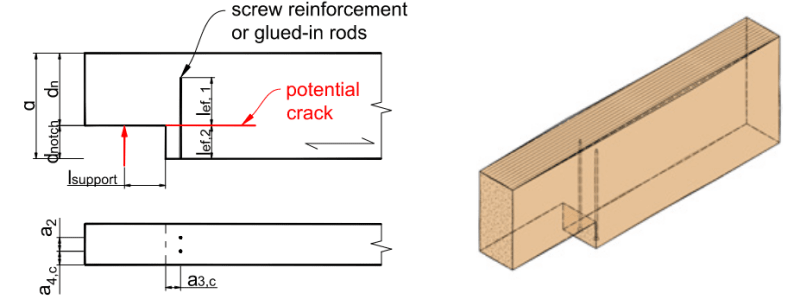briceandon
Structural
- Apr 22, 2015
- 2
For a timber floor joist, is there any allowance/guidance if you want to exceed the 1/4D maximum notch at the end of a joist, which is specified by NDS/IRC? NDS 2015 is the applicable spec for the project, but I could only find a copy of the 2005 NDS commentary. In this commentary, Article C4.4.3 indicates the 1/4D notch is good practice and recommended partially because of the stress concentration at the notch corner and the potential for splits at the corner. My thought is that if the joist is tapered at the ends, rather than notched, the stress concentration would be greatly reduced and exceeding the 1/4D may be possible, provided the remaining sections meet the allowable stresses.
For some background information, my project is to strengthen/stiffen an existing floor in a house built in 1897, and my plan is to install a sister joist at each existing joist. The existing joists are 2"x8" rough cut lumber (measured dimension) spaced at 24" and they are notched 2" at the sill beam.
Based on the current live loads and span (14.7ft), the sister joists (SPF #2) need to be 2x10s; however, to maintain the same floor elevation, a notch >1/4D would be required. If I use a 1/4D notch, the floor will be raised and there will be an ~1” difference between floors at the room threshold. I tried to stop the sister joist short of the supports and just use the sister joist to stiffen/strength the existing joists but the calculated shear stress in the existing beams is too high.
I’m looking for a section in a code/spec that discusses using notches/tapers >1/4D. Any insight would be greatly appreciated.
For some background information, my project is to strengthen/stiffen an existing floor in a house built in 1897, and my plan is to install a sister joist at each existing joist. The existing joists are 2"x8" rough cut lumber (measured dimension) spaced at 24" and they are notched 2" at the sill beam.
Based on the current live loads and span (14.7ft), the sister joists (SPF #2) need to be 2x10s; however, to maintain the same floor elevation, a notch >1/4D would be required. If I use a 1/4D notch, the floor will be raised and there will be an ~1” difference between floors at the room threshold. I tried to stop the sister joist short of the supports and just use the sister joist to stiffen/strength the existing joists but the calculated shear stress in the existing beams is too high.
I’m looking for a section in a code/spec that discusses using notches/tapers >1/4D. Any insight would be greatly appreciated.

